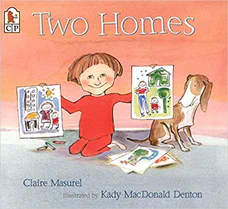Two Homes
Written by Claire Masurel
Illustrated by Kady MacDonald Denton
40 pages
•
Published 2003 (Candlewick Press)

Recommended Age Range: Preschool through Kindergarten
Publisher's Summary:
At Mommy’s house, Alex has a soft chair. At Daddy’s house, Alex has a rocking chair. In each home, Alex also has a special bedroom and lots of friends to play with. But whether Alex is with Mommy or with Daddy, one thing always stays the same — Alex is loved. The gently reassuring text focuses on what is gained rather than what is lost when parents divorce, while the sensitive illustrations, depicting two unique homes in all their small details, firmly establish Alex’s place in both of them.

Dr. Annie's Takeaways
Recommended for: This story is simple and soothing and provides a positive yet realistic example of what it might be like for a child to have two homes. This book would be best read with a child after a separation or divorce has already been explained and a move to two homes is imminent. This book could also help to normalize having two homes for a child whose parents have already separated or who have never lived together.
Evidence-Based Practices:
Psychoeducation
Tone: Matter-of-fact, reassuring
Story Quality: Written in first person, this book is simple and concrete, with no confusing language or concepts. It touches on many day-to-day objects and routines that matter greatly to most young children (e.g., favorite chairs, front doors, toothbrushes), and the repetitive structure of the book (e.g., “I have two ______. I have ______ at Mommy’s. I have _____ at Daddy’s”) is soothing in its predictability.
Illustrations: I almost love the illustrations. They have a lot of complexity and detail, and many of the pages are quite beautiful. Alex’s face, though, is a bit odd, and some might find it a tiny bit creepy. If the cover doesn’t throw you off, proceed.
Representation: Alex is a White child–likely a boy–with short hair but very few other gender indicators. Alex has a mommy and a daddy who live in separate homes and have shared custody (no specifics of the custody arrangement are included). Both parents are White. Alex’s father lives in a suburban neighborhood, and Alex’s mother lives in a city. There is no mention of the word “divorce” or separation–the parents already live in two separate homes at the start of the story.
Psychological Practices: This story normalizes having two homes and provides hope that a child will soon have new routines and comfortable spaces in both places. The concreteness of this story (e.g., “I have two front doors. My coat goes here. My coat goes there”) combats the often-frightening unknowns of a divorce or separation and helps a child to picture what having two homes might look like for them. The book also reminds children that both of their parents love them no matter where they are and whether or not they are together.
Concerns: None.
